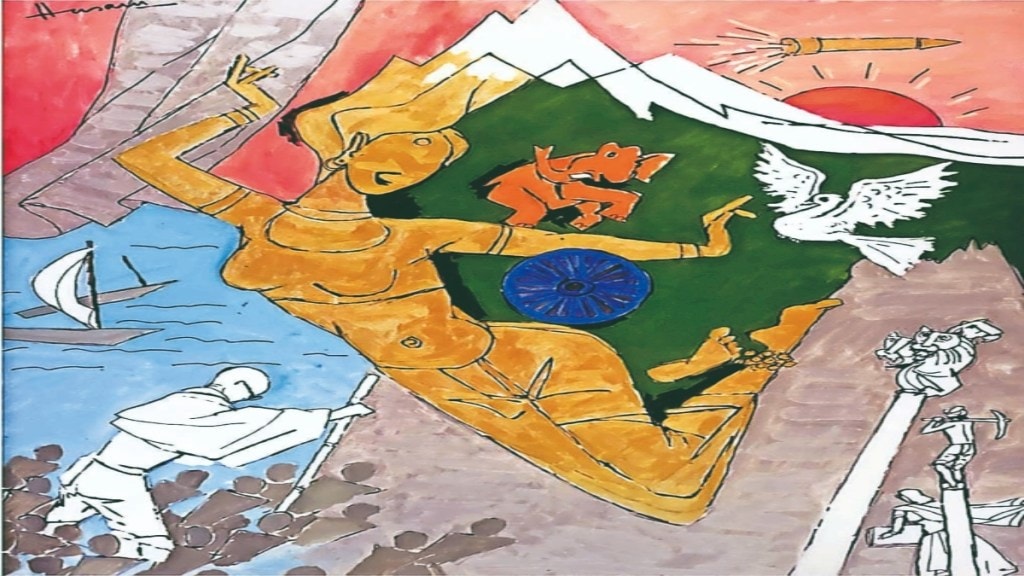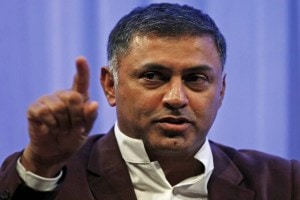The tricolour and Mahatma Gandhi appear to burst out of MF Husain’s oil on canvas titled, Invocation of Peace, the brush strokes painting a story of hope on the canvas from more than half a century ago. The artist’s optimism for a nation he believed in is the recurring theme of Husain: The Timeless Modernist, a new exhibition of the works of the modernist master at the DAG gallery in the national capital.
A mammoth 116 works spanning six decades from the 1950s mounted in the exhibition reveal a tireless artist at work on an array of mediums displaying a whole range of artistic expressions and practices. While Mahatma Gandhi, Mother Teresa and Madhuri Dixit become the artist’s muse for a series of works, the show traces the long journey of Husain in step with the progress of a new nation.
“Husain: The Timeless Modernist seeks to encapsulate the breadth and depth of one of India’s foremost artists’ career. An exhibition of this magnitude warranted a collection that could translate every phase of Husain’s artistic journey,” says DAG’s CEO and managing director Ashish Anand. Taken from the DAG collection, the exhibition also benefits from a few works of Husain in private collections to complete the scope and ambition of the show.
Presented in six sections mirroring the artist’s style as well as the influences on him, Husain: The Timeless Modernist (October 25-December 14) gathers a number of works that cement his support for secularism. Among them are a 1990 series, Humanism, in which brush strokes cohabit letters from Devanagiri and Arabic alphabets. Self-portraits abound too. One such, titled Maqbool Fida, from 1990 in chinese-collé print on paper shows a kurta-and-pyjama-clad Husain existing in black, white and pink shades.
Another self-portrait, this time an acrylic on canvas titled Portrait of a Painter Surrounded by His Own Images, portrays the artist in military fatigue, but carrying a paint brush. Around the artist are horse riders, Mother Teresa holding a baby, and a semi-naked man with an umbrella, all canvas images of Husain himself. The exhibition also presents Husain’s response to societal crises as an artist through works based on the 1971 India-Pakistan War, the Nellie massacre of 1983 in Assam and the Emergency.
Husain’s much-loved conversations through his works with prominent figures from a variety of fields, like Mahatma Gandhi, Jawaharlal Nehru, Rabindranath Tagore, Mother Teresa and Satyajit Ray reflect his constant attempts to engage with voices. In a painting on legendary Japanese filmmaker Akira Kurosawa, he leaves an inscription in the middle of the work: “I have always felt from the first time I met you that you are the kind of man who is like a huge tree. A great tree in the woods of India.” The inscription, which is surrounded by branches of a tree, is not surprisingly, Kurosawa’s words. Husain’s portraits match his famous Toy Series, some in gouache on wood with iron nails, and others made of painted wood and iron on board.
Born in the temple town of Pandharpur in Maharashtra in 1913, Husain studied art in Indore and later at the JJ School of Art, Mumbai. Homeless in Mumbai in the late 1930s, he slept on the pavement before painting big Bollywood billboards to earn a living. A co-founder of the Bombay Progressive Artists’ Group formed during the Partition with such celebrated artists as SH Raza and FN Souza, Husain achieved acclaim through his works that questioned conformity. A self-styled showman, he would go on to make movies, face protests and even death threats for exercising his artistic freedom. A recipient of the country’s highest civilian honours and a nominated member of the Rajya Sabha, Husain left India in 2006 on a self-imposed exile, to share his time between London and Dubai, after facing backlash for hurting religious sentiments. He passed away in London in 2011 aged 98.
“His exhibitions were booked years in advance, and viewers from miles away queued up to admire his art, and an encounter with the artist himself, if it happened, was an unexpected bonus,” writes filmmaker-curator Ina Puri about Husain in a book, also titled Husain: The Timeless Modernist, published by DAG to coincide with the exhibition. “Collectors treasured not just the artwork they had acquired but also the stories associated with the artist,” says Puri, who met the artist on the sets of the Madhuri Dixit-starring Gaja Gamini, Husain’s debut as a film director, in 2000.
“With Husain, you lost yourself in his train of thought as he explained his art, on canvas, sets or celluloid. Very few creative geniuses have that ability to transport you to another world as he did, tumbling over his words, his eyes shining with an almost manic energy as he articulated his contemplations. It was with the same ease that his brush moved across the canvas, creating images with (seemingly) effortless strokes,” adds Puri.
Faizal Khan is a freelancer








